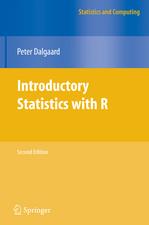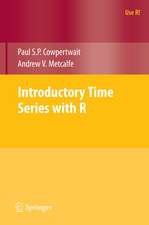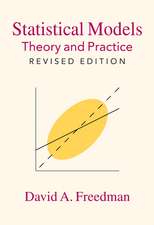Ranking and Prioritization for Multi-indicator Systems: Introduction to Partial Order Applications: Environmental and Ecological Statistics, cartea 5
Autor Rainer Brüggemann, Ganapati P. Patilen Limba Engleză Paperback – 27 sep 2013
| Toate formatele și edițiile | Preț | Express |
|---|---|---|
| Paperback (1) | 643.34 lei 6-8 săpt. | |
| Springer – 27 sep 2013 | 643.34 lei 6-8 săpt. | |
| Hardback (1) | 648.24 lei 3-5 săpt. | |
| Springer – 8 iul 2011 | 648.24 lei 3-5 săpt. |
Preț: 643.34 lei
Preț vechi: 756.86 lei
-15% Nou
Puncte Express: 965
Preț estimativ în valută:
123.11€ • 131.64$ • 102.64£
123.11€ • 131.64$ • 102.64£
Carte tipărită la comandă
Livrare economică 18 aprilie-02 mai
Preluare comenzi: 021 569.72.76
Specificații
ISBN-13: 9781461429685
ISBN-10: 1461429684
Pagini: 364
Ilustrații: XXVI, 338 p.
Dimensiuni: 155 x 235 x 19 mm
Greutate: 0.5 kg
Ediția:2011
Editura: Springer
Colecția Springer
Seria Environmental and Ecological Statistics
Locul publicării:New York, NY, United States
ISBN-10: 1461429684
Pagini: 364
Ilustrații: XXVI, 338 p.
Dimensiuni: 155 x 235 x 19 mm
Greutate: 0.5 kg
Ediția:2011
Editura: Springer
Colecția Springer
Seria Environmental and Ecological Statistics
Locul publicării:New York, NY, United States
Public țintă
Professional/practitionerCuprins
Preface.- Why Prioritization, Why Ranking.- Partial Order and Hasse Diagrams.- Simple Combinatorial Structures.- Sensitivity and Ambiguity.- Structures of Partial Orders.- Hasse Diagrams Based on Transformed Data Matrices.- Reducing the Number of Incomparabilities.- Formal Concept Analysis.- Methods to Obtain Linear or Weak Orders by Means of Partial Order.- Comparison of Partial, Linear and Weak Orders.- Illustrative Case Studies.- Case Studies: Child Development (Sociology).- Case Study: Stream Channel Stability Infrastructure at Bridge Crossings (Engineering Sciences).- Case Study: Watersheds Analysis (Hydrology).- Case Study: Environmental Performance Index (EPI) (Human and Environmental Health).- Partial Order and Related Disciplines.- Partial Order and Software.- Ranking and Prioritization with Partial Order for Multi-Indicator Systems - An Integrative View with a Look Forward.- Appendix.- Index.
Recenzii
From the reviews:
“The main aim of the book is to introduce the modern tools and methodologies of the so-called partial order ranking for prioritization of objects by many different characteristics. … is addressed to graduate students and specialists in environmental, ecological, and other applied sciences requiring ordering and prioritization of many objects by numerous characteristics. … these new methods of partial order analysis can be insightful and useful, and extend the regular tool-kit of statisticians applying more conventional methods of PCA, factor analysis, data clustering, and segmentation.” (Stan Lipovetsky, Technometrics, Vol. 54 (2), May, 2012)
“The main aim of the book is to introduce the modern tools and methodologies of the so-called partial order ranking for prioritization of objects by many different characteristics. … is addressed to graduate students and specialists in environmental, ecological, and other applied sciences requiring ordering and prioritization of many objects by numerous characteristics. … these new methods of partial order analysis can be insightful and useful, and extend the regular tool-kit of statisticians applying more conventional methods of PCA, factor analysis, data clustering, and segmentation.” (Stan Lipovetsky, Technometrics, Vol. 54 (2), May, 2012)
Textul de pe ultima copertă
Ranking issues are found everywhere. For example, bank houses, universities, towns, watersheds etc. are ranked. But also assessment of students in one discipline is a ranking. This last example is trivial, because we have only one criterion, namely the quality of the student in that discipline. In the other cases ranking can be a very hard job. Why? There is often no measure. How do we measure towns with respect to living quality? How do we measure the hazard exerted by chemicals? No chemical has its intrinsic identity card where its hazard can be identified.
Thus multi-indicator systems come into play. We gather indicators which help to characterize the items of interest for ranking. Measurement of indicators, selecting indicators, testing indicators. And we arrive at a multi-indicator system.
We have gathered useful information for ranking. However, we do not know how to derive ranking from the multitude of valuable information. In a popular approach, the indicator values are weight-averaged. The resulting weighted averages are used to obtain the ranking.
We offer the mathematical tool of partial order as a tool to get insight into the process, starting with the multi-indicator system and finishing up with ranking. Application of partial order involving multi-indicator systems is in its initial phases and is advancing with more and more tools.
This book provides a timely introduction to the partial order theory and its techniques with worked out illustrations and applications to a variety of live case studies. It is written for interested social and technical scientists, statisticians, , computer scientists, and graph theorists, stakeholders, instructors, and students at graduate and senior undergraduate levels. We have enjoyed writing it. You will hopefully enjoy reading it and using it.
Thus multi-indicator systems come into play. We gather indicators which help to characterize the items of interest for ranking. Measurement of indicators, selecting indicators, testing indicators. And we arrive at a multi-indicator system.
We have gathered useful information for ranking. However, we do not know how to derive ranking from the multitude of valuable information. In a popular approach, the indicator values are weight-averaged. The resulting weighted averages are used to obtain the ranking.
We offer the mathematical tool of partial order as a tool to get insight into the process, starting with the multi-indicator system and finishing up with ranking. Application of partial order involving multi-indicator systems is in its initial phases and is advancing with more and more tools.
This book provides a timely introduction to the partial order theory and its techniques with worked out illustrations and applications to a variety of live case studies. It is written for interested social and technical scientists, statisticians, , computer scientists, and graph theorists, stakeholders, instructors, and students at graduate and senior undergraduate levels. We have enjoyed writing it. You will hopefully enjoy reading it and using it.
Caracteristici
Discusses main topics of ranking applying partial order theory Is about how far simple order methods can be useful for the ordinal analysis of data matrices The reader will learn how to apply unclear methods in partial order analysis Includes supplementary material: sn.pub/extras

















